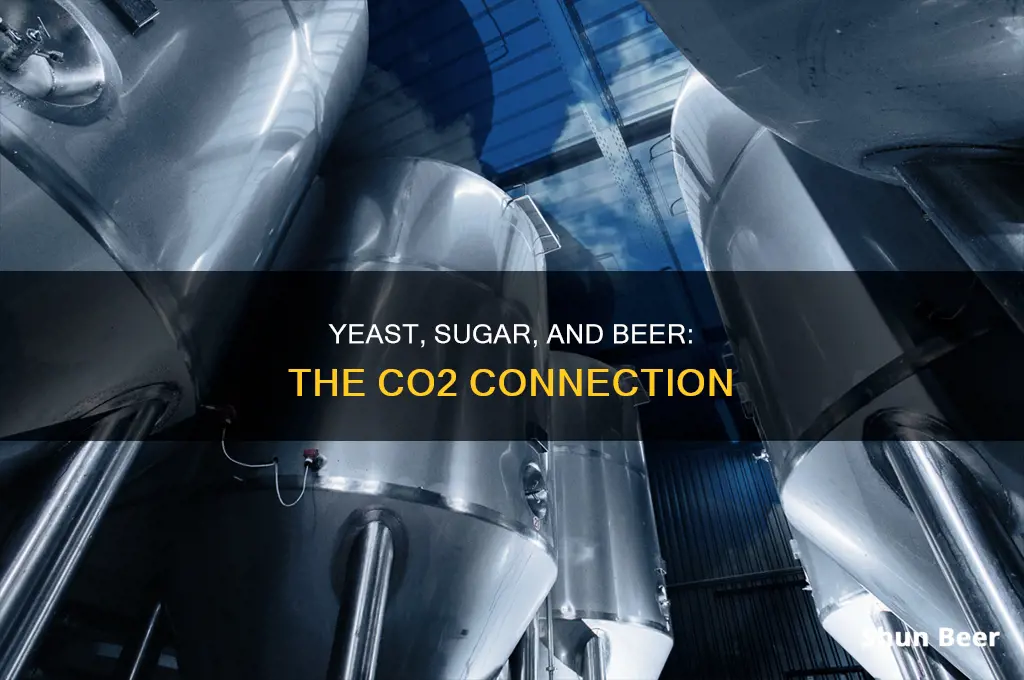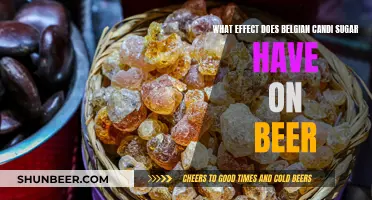
Yeast is a member of the fungi family and is a eukaryotic micro-organism. In the process of fermentation, yeast converts sugar into carbon dioxide (CO2) and ethyl alcohol. This process is carried out by yeast cells using a range of enzymes. The carbon dioxide produced bubbles through the liquid and dissipates into the air. In confined spaces, the carbon dioxide dissolves in the liquid, making it fizzy. The pressure build-up caused by CO2 production in a confined space can be immense and can cause the explosion of a sealed glass bottle.
What You'll Learn
- Yeast converts sugar into CO2 and alcohol during fermentation
- CO2 is collected and used to boost beer's CO2 level
- CO2 is dissolved in beer, with solubility increasing as temperature decreases
- CO2 affects yeast fermentation rates and metabolic products
- CO2 is produced when a mole of glucose is converted into two moles of ethanol and two moles of CO2

Yeast converts sugar into CO2 and alcohol during fermentation
During fermentation, the yeast cells undergo a series of complex reactions that convert sugar into CO2 and alcohol. The overall process can be simplified into the following equation:
> Sugar + Energy (stored in ATP) => Alcohol + Carbon Dioxide + Energy (Glucose)
However, in reality, the process is far more complex, and there are many by-products formed during fermentation. In addition to CO2 and alcohol, the sugar is also incorporated into other by-products such as yeast biomass, acids (pyruvic, acetaldehyde, ketoglutaric, lactic), and glycerol. The efficiency of the yeast and fermentation conditions can alter the proportions of these by-products, meaning a simple single formula cannot accurately describe the process.
The conversion of sugar into CO2 and alcohol by yeast is essential for the production of alcoholic beverages like beer. The CO2 produced during fermentation creates the "fizz" or "condition" characteristic of beer, and it can also be collected and used to boost the level of CO2 in the finished product. The pressure build-up caused by CO2 production in a confined space, such as a sealed bottle, can be significant and even cause an explosion.
The ability of yeast cells to convert sugar into CO2 and alcohol depends on enzymes. Several enzymes are involved in this process, with the final step being the Zymase reduction, which converts acetaldehyde/glycerol into ethyl alcohol. High concentrations of alcohol can destroy these enzymes and kill the yeast cells. Therefore, different strains of yeast have varying levels of alcohol tolerance, typically ranging from 5% to 21% alcohol by volume.
Beer Sugar Content: Is It Really That High?
You may want to see also

CO2 is collected and used to boost beer's CO2 level
CO2 is collected and used to boost a beer's CO2 level through a variety of methods. The most common techniques include absorption, adsorption, membrane separation, and cryogenic separation. Absorption technology uses a solvent to absorb CO2, while adsorption relies on solid adsorbents like zeolites or activated charcoal. Membrane separation uses specialized membranes to selectively allow CO2 passage, and cryogenic separation involves lowering the gas mixture's temperature to condense CO2. These methods allow industries to capture and reuse CO2, reducing their carbon footprint and providing cost savings.
One notable example of successful CO2 capture and reuse is Familia Torres, a Spanish wine group. They collect CO2 during winemaking in inflatable balloons above fermentation tanks, then compress and store it for later use. This technology helps them reuse about 20 tonnes of emission-neutral CO2 annually, reducing their carbon footprint and eliminating the need to purchase CO2.
CO2 collection and reuse offer a promising solution for reducing emissions and promoting sustainability. By capturing and repurposing CO2, industries can contribute to a more sustainable future while maintaining product quality.
Shake Beer: Added Sugar or Natural Sweetness?
You may want to see also

CO2 is dissolved in beer, with solubility increasing as temperature decreases
CO2 is highly soluble in beer, and this solubility increases as the temperature decreases. This is because lower temperatures cause the CO2 to become more soluble, increasing the Henry's constant. This is important for beer as it is served at low temperatures, typically between 1-3°C, which results in a higher dissolved CO2 level and a greater "bite". This "bite" is caused by carbonic acid, which is created when CO2 is dissolved into an aqueous liquid.
The solubility of CO2 in beer is influenced by several factors, including temperature, pressure, and beer composition. The amount of CO2 in beer can be determined using empirical or semi-empirical formulas or pressure/temperature charts. The solubility of CO2 in beer is crucial for the desired bubbling process and directly impacts various sensory properties, such as the frequency of bubble formation and the perception of dissolved and gas-phase CO2.
The concentration of dissolved CO2 in beer can be increased by cooling the beer and applying pressure, which is commonly done with kegs. This process involves carbonating the beer with top pressure, which can take a few days. To speed up the process, a higher pressure can be applied initially and then lowered to the equilibrium value. Additionally, carbonation can be enhanced by pushing fine bubbles of CO2 through an aerating stone into the bottom of the keg.
The level of carbonation in beer is typically expressed in "volumes" of CO2, which represents the space the gas would take up at standard temperature and pressure (STP). On average, beer has a carbonation level of 2.5 volumes of CO2. However, there is variation among different styles of beer, with cask ales having 1.5-2.0 volumes and wheat beers having 3.0-5.0 volumes.
Overall, the solubility of CO2 in beer is a complex topic that involves the interplay of various factors, and it plays a crucial role in the desired bubbling and sensory characteristics of the beverage.
The Truth About IPA Beer and Sugar Content
You may want to see also

CO2 affects yeast fermentation rates and metabolic products
CO2 concentration has been shown to have a significant impact on yeast fermentation rates and metabolic products. In a study by Guadalupe-Daqui et al. (2023), the partial removal of CO2 from the fermenting media was found to increase the fermentation rate and the number of viable yeast cells. The study also revealed that a reduced CO2 concentration led to higher ethanol, glycerol, and volatile organic compound concentrations, while decreasing the synthesis of trehalose, a yeast stress indicator.
The study further highlighted the negative effects of high CO2 concentrations on yeast, including inhibition of biomass production, enzymatic activity, cell membrane function, and nutrient transport. Additionally, high CO2 levels can affect the formation of volatile organic compounds, impacting the flavour and aroma of the final product.
Optimising CO2 concentration during fermentation can have a significant impact on the efficiency and quality of the brewing process. Brewers can manipulate CO2 levels to achieve the desired fermentation rate, yeast health, and sensory characteristics of the beer.
Cider Beers: Sugar Content and Health Considerations
You may want to see also

CO2 is produced when a mole of glucose is converted into two moles of ethanol and two moles of CO2
The process of fermentation is what enables the production of beer, wine, and spirits. Humans have been taking advantage of the metabolic processes of the tiny fungus called yeast to create alcoholic beverages for thousands of years.
The process of alcoholic fermentation involves yeast cells converting sugar into carbon dioxide (CO2) and ethyl alcohol (ethanol). This process is facilitated by a range of enzymes. The overall chemical reaction is as follows:
> C6H12O6 + 2 ADP + 2 Pi → 2 C2H5OH + 2 CO2 + 2 ATP
In this equation, one mole of glucose (C6H12O6) is converted into two moles of ethanol (C2H5OH) and two moles of carbon dioxide (CO2). This process also produces two moles of adenosine triphosphate (ATP), a molecule that is essential for many cellular processes.
The process of fermentation is quite complex, and there are many by-products formed during the conversion of sugar into alcohol and CO2. These by-products include yeast biomass, acids (such as pyruvic, acetaldehyde, ketoglutaric, and lactic acid), and glycerol. The efficiency of the yeast and fermentation conditions, such as temperature, can alter the proportions of these by-products.
The CO2 produced during fermentation is what gives beer its "fizz" or "condition". In confined spaces, such as sealed bottles or kegs, the CO2 dissolves in the liquid, creating carbonation. The pressure build-up caused by CO2 production in these confined spaces can be immense and can even cause explosions. The solubility of CO2 in beer increases as the temperature decreases, which is why beers served very cold have a sharper "bite" or tingling sensation on the tongue.
Sour Beers: High Sugar Content or Healthy Choice?
You may want to see also
Frequently asked questions
Yeast is a type of fungus that feeds on sugars and converts them into carbon dioxide and alcohol through a process called fermentation.
A standard 20-litre brew can produce between 400 and 600 litres of CO2.
The CO2 produced during fermentation escapes into the air or can be collected and used later to boost the level of CO2 in the finished beer, a process known as carbonation.
High concentrations of alcohol destroy the enzymes that yeast needs to function and can eventually kill the yeast cells. Brewer's yeast, for example, cannot withstand much beyond 5-6% alcohol by volume.







